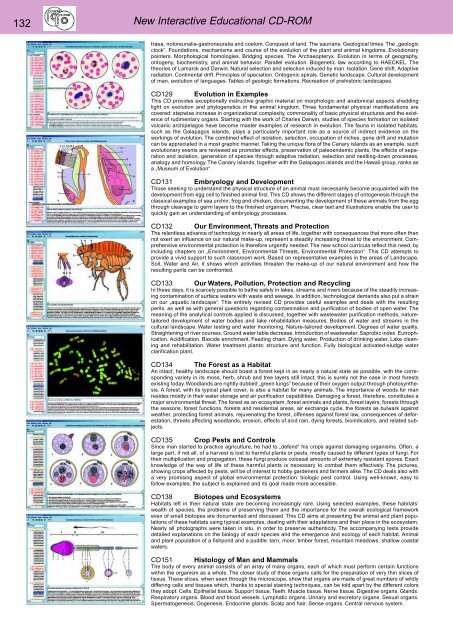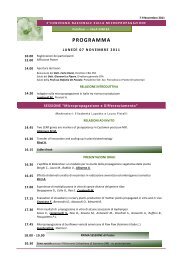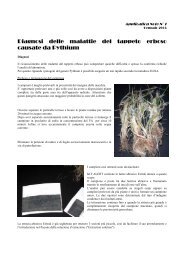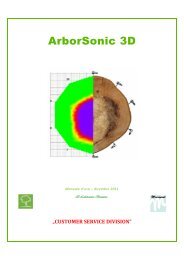BIOLOGY - microscopia.info
BIOLOGY - microscopia.info
BIOLOGY - microscopia.info
Create successful ePaper yourself
Turn your PDF publications into a flip-book with our unique Google optimized e-Paper software.
132<br />
New Interactive Educational CD-ROM<br />
traea, notoreunalia-gastroneuralia and coelom. Conquest of land. The saurians. Geological times. The „geologic<br />
clock“. Foundations, mechanisms and course of the evolution of the plant and animal kingdoms. Evolutionary<br />
pointers. Morphological homologies. Bridging species. The Archaeopteryx. Evolution in terms of geography,<br />
ontogeny, biochemistry, and animal behavior. Parallel evolution. Biogenetic law according to HAECKEL. The<br />
theories of Lamarck and Darwin. Natural selection and selection induced by man. Isolation. Gene shift. Adaptive<br />
radiation. Continental drift. Principles of speciation. Ontogenic spirals. Genetic landscape. Cultural development<br />
of man, evolution of languages. Tables of geologic formations. Recreation of prehistoric landscapes.<br />
CD129 Evolution in Examples<br />
This CD provides exceptionally instructive graphic material on morphologic and anatomical aspects shedding<br />
light on evolution and phylogenetics in the animal kingdom. Three fundamental physical manifestations are<br />
covered: stepwise increase in organizational complexity, commonality of basic physical structures and the existence<br />
of rudimentary organs. Starting with the work of Charles Darwin, studies of species formation on isolated<br />
volcanic archipelagos have become master examples of research in evolution. The fauna in isolated habitats,<br />
such as the Galapagos islands, plays a particularly important role as a source of indirect evidence on the<br />
workings of evolution. The combined effect of isolation, selection, occupation of niches, gene drift and mutation<br />
can be appreciated in a most graphic manner. Taking the unique flora of the Canary islands as an example, such<br />
evolutionary events are reviewed as promoter effects, preservation of paleoendemic plants, the effects of separation<br />
and isolation, generation of species through adaptive radiation, selection and nestling-down processes,<br />
analogy and homology. The Canary islands, together with the Galapagos islands and the Hawaii group, ranks as<br />
a „Museum of Evolution“.<br />
CD131 Embryology and Development<br />
Those seeking to understand the physical structure of an animal must necessarily become acquainted with the<br />
development from egg cell to finished animal first. This CD shows the different stages of ontogenesis through the<br />
classical examples of sea urchin, frog and chicken, documenting the development of these animals from the egg<br />
through cleavage to germ layers to the finished organism. Precise, clear text and illustrations enable the user to<br />
quickly gain an understanding of embryology processes.<br />
CD132 Our Environment, Threats and Protection<br />
The relentless advance of technology in nearly all areas of life, together with consequences that more often than<br />
not exert an influence on our natural make-up, represent a steadily increasing threat to the environment. Comprehensive<br />
environmental protection is therefore urgently needed. The new school curricula reflect this need, by<br />
including chapters on „Environment, Environmental Threats, Environmental Protection“. This CD attempts to<br />
provide a vivid support to such classroom work. Based on representative examples in the areas of Landscape,<br />
Soil, Water and Air, it shows which activities threaten the make-up of our natural environment and how the<br />
resulting perils can be confronted.<br />
CD133 Our Waters, Pollution, Protection and Recycling<br />
In these days, it is scarcely possible to bathe safely in lakes, streams and rivers because of the steadily increasing<br />
contamination of surface waters with waste and sewage. In addition, technological demands also put a strain<br />
on our „aquatic landscape“. This entirely revised CD provides useful examples and deals with the resulting<br />
perils, as well as with general questions regarding contamination and purification of bodies of open water. The<br />
meaning of the analytical controls applied is discussed, together with wastewater purification methods, naturetailored<br />
development of water bodies and lake rehabilitation measures. Bodies of water and streams in the<br />
cultural landscape. Water testing and water monitoring. Nature-tailored development. Degrees of water quality.<br />
Straightening of river courses. Ground water table decrease. Introduction of wastewater. Saprobic index. Eutrophication.<br />
Acidification. Biocide enrichment. Feeding chain. Dying water. Production of drinking water. Lake cleaning<br />
and rehabilitation. Water treatment plants: structure and function. Fully biological activated-sludge water<br />
clarification plant.<br />
CD134 The Forest as a Habitat<br />
An intact, healthy landscape should boast a forest kept in as nearly a natural state as possible, with the corresponding<br />
variety in its moss, herb, shrub and tree layers still intact; this is surely not the case in most forests<br />
existing today. Woodlands are rightly dubbed „green lungs“ because of their oxygen output through photosynthesis.<br />
A forest, with its typical plant cover, is also a habitat for many animals. The importance of woods for man<br />
resides mostly in their water storage and air purification capabilities. Damaging a forest, therefore, constitutes a<br />
major environmental threat. The forest as an ecosystem, forest animals and plants, forest layers, forests through<br />
the seasons, forest functions, forests and residential areas, air exchange cycle, the forests as bulwark against<br />
weather, protecting forest animals, rejuvenating the forest, offenses against forest law, consequences of deforestation,<br />
threats affecting woodlands, erosion, effects of acid rain, dying forests, bioindicators, and related subjects.<br />
CD135 Crop Pests and Controls<br />
Since man started to practice agriculture, he had to „defend“ his crops against damaging organisms. Often, a<br />
large part, if not all, of a harvest is lost to harmful plants or pests, mostly caused by different types of fungi. For<br />
their multiplication and propagation, these fungi produce colossal amounts of extremely resistant spores. Exact<br />
knowledge of the way of life of these harmful plants is necessary to combat them effectively. The pictures,<br />
showing crops affected by pests, will be of interest to hobby gardeners and farmers alike. The CD deals also with<br />
a very promising aspect of global environmental protection: biologic pest control. Using well-known, easy to<br />
follow examples, the subject is explained and its goal made more accessible.<br />
CD138 Biotopes und Ecosystems<br />
Habitats left in their natural state are becoming increasingly rare. Using selected examples, these habitats’<br />
wealth of species, the problems of preserving them and the importance for the overall ecological framework<br />
even of small biotopes are documented and discussed. This CD aims at presenting the animal and plant populations<br />
of these habitats using typical examples, dealing with their adaptations and their place in the ecosystem.<br />
Nearly all photographs were taken in situ, in order to preserve authenticity. The accompanying texts provide<br />
detailed explanations on the biology of each species and the emergence and ecology of each habitat. Animal<br />
and plant population of a fishpond and a puddle. tarn, moor, timber forest, mountain meadows, shallow coastal<br />
waters.<br />
CD151 Histology of Man and Mammals<br />
The body of every animal consists of an array of many organs, each of which must perform certain functions<br />
within the organism as a whole. The closer study of these organs calls for the preparation of very thin slices of<br />
tissue. These slices, when seen through the microscope, show that organs are made of great numbers of wildly<br />
differing cells and tissues which, thanks to special staining techniques, can be told apart by the different colors<br />
they adopt. Cells. Epithelial tissue. Support tissue. Teeth. Muscle tissue. Nerve tissue. Digestive organs. Glands.<br />
Respiratory organs. Blood and blood vessels. Lymphatic organs. Urinary and excretory organs. Sexual organs.<br />
Spermatogenesis. Oogenesis. Endocrine glands. Scalp and hair. Sense organs. Central nervous system.







